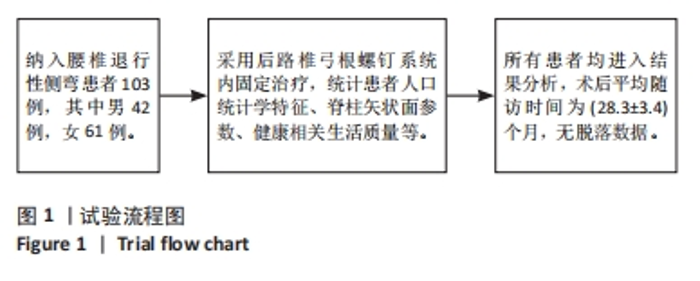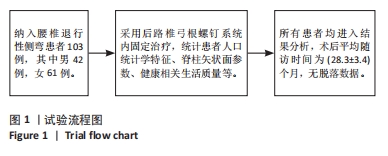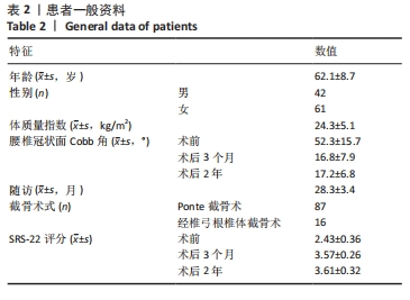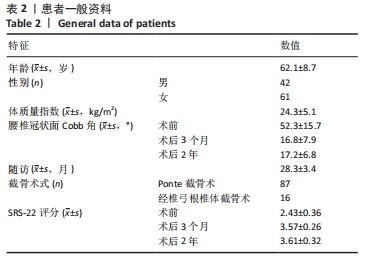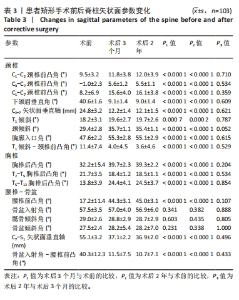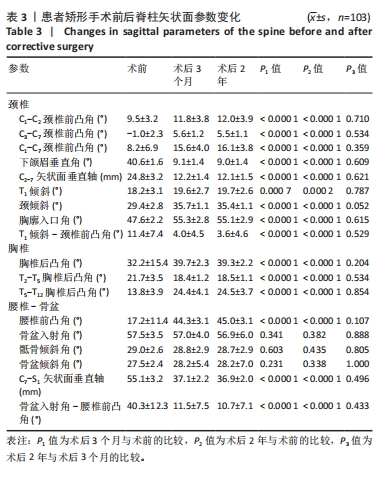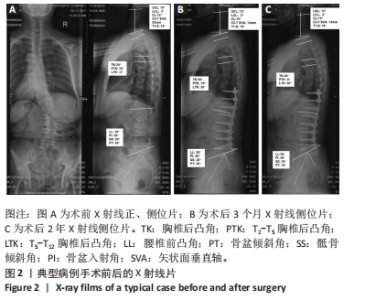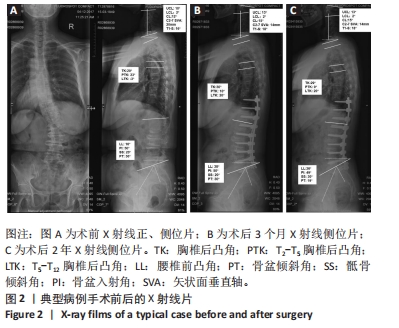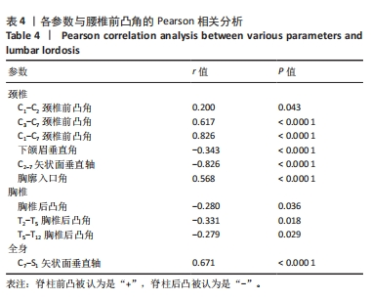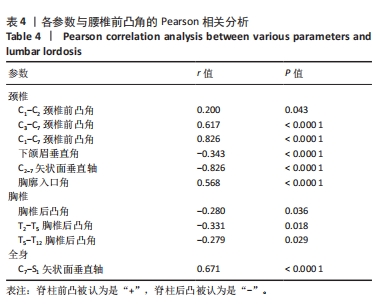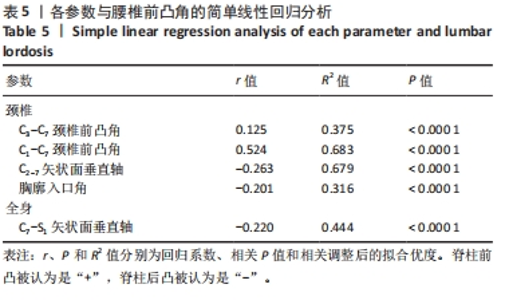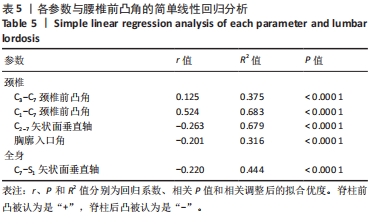Chinese Journal of Tissue Engineering Research ›› 2025, Vol. 29 ›› Issue (33): 7196-7202.doi: 10.12307/2025.755
Previous Articles Next Articles
Compensatory alignment changes of cervical and thoracic spine after correction of lumbar degenerative scoliosis
Cao Yong, Li Xin, Chen Zhigang, Gu Honglin, Lyu Shujun
- Hai’an People’s Hospital (Hai’an Hospital Affiliated to Nantong University), Nantong 226600, Jiangsu Province, China
-
Received:2024-05-23Accepted:2024-08-05Online:2025-11-28Published:2025-04-12 -
Contact:Lyu Shujun, Chief physician, Hai’an People’s Hospital (Hai’an Hospital Affiliated to Nantong University), Nantong 226600, Jiangsu Province, China -
About author:Cao Yong, MS, Associate chief physician, Hai’an People’s Hospital (Hai’an Hospital Affiliated to Nantong University), Nantong 226600, Jiangsu Province, China
CLC Number:
Cite this article
Cao Yong, Li Xin, Chen Zhigang, Gu Honglin, Lyu Shujun. Compensatory alignment changes of cervical and thoracic spine after correction of lumbar degenerative scoliosis[J]. Chinese Journal of Tissue Engineering Research, 2025, 29(33): 7196-7202.
share this article
Add to citation manager EndNote|Reference Manager|ProCite|BibTeX|RefWorks
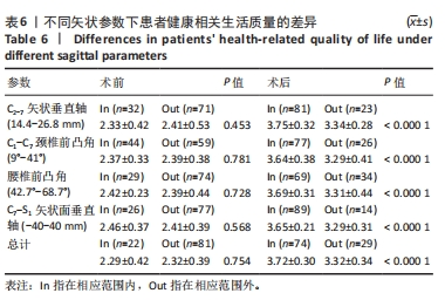
2.6 患者矢状参数与健康相关生活质量的相关性 比较C2-7矢状面垂直轴在14.4-26.8 mm范围内和范围外患者的SRS-22评分,发现在手术前无显著性差异(P=0.453),而在手术后差异有显著性意义(P < 0.000 1)。另外比较了C1-C7颈椎前凸角在9°-41°范围内外的患者、腰椎前凸角在42.7°-68.7°范围内外的患者,以及C7-S1矢状面垂直轴在-40-40 mm范围内外患者的SRS-22评分,发现了与上述一致的结果。作者还发现,符合C1-C7颈椎前凸角、C2-7矢状面垂直轴、腰椎前凸角和C7-S1矢状面垂直轴综合标准的患者在手术前与不符合综合标准的患者之间无显著性差异(P=0.754),而在手术后差异有显著性意义(P < 0.000 1)。见表6。"
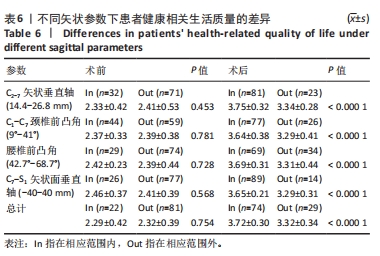
| [1] WONG E, ALTAF F, OH LJ, et al. Adult Degenerative Lumbar Scoliosis. Orthopedics. 2017;40(6):e930-e939. [2] LOWE T, BERVEN SH, SCHWAB FJ, et al. The SRS classification for adult spinal deformity: Building on the King/Moe and Lenke classification systems. Spine (Phila Pa 1976). 2006;31(19 Suppl):S119-125. [3] YORK PJ, KIM HJ. Degenerative Scoliosis. Curr Rev Musculoskelet Med. 2017;10(4):547-558. [4] SIMON J, LONGIS PM, PASSUTI N. Correlation between radiographic parameters and functional scores in degenerative lumbar and thoracolumbar scoliosis. Orthop Traumatol Surg Res. 2016;103(2): 285-290. [5] 陆明,马华松,王晓平,等.腰椎退变性侧弯植入物置入的内固定治疗[J].中国组织工程研究,2012,16(44):8324-8331. [6] HAN F, WEISHI L, ZHUORAN S, et al. Sagittal plane analysis of the spine and pelvis in degenerative lumbar scoliosis. J Orthop Surg (Hong Kong). 2017;25(1):2309499016684746. [7] ZHANG H, DU Y, ZHAO Y, et al. Outcomes of Ponte osteotomy combined with posterior lumbar interbody fusion for reconstruction of coronal and sagittal balance in degenerative scoliosis. J Orthop Surg Res. 2023; 18(1): 904. [8] TANG X, ZHAO J, ZHANG Y. Radiographic, clinical, and patients’ assessment of segmental direct vertebral body derotation versus simple rod derotation in main thoracic adolescent idiopathic scoliosis: a prospective, comparative cohort study. Eur Spine J. 2014;24(2):298-305. [9] BERGEY DL, VILLAVICENCIO AT, GOLDSTEIN T, et al. Endoscopic lateral transpsoas approach to the lumbar spine. Spine (Phila Pa 1976). 2004;29(15):1681-1688. [10] WANG T, WANG H, MA L, et al. Correction of sagittal imbalance in treatment for adult degenerative scoliosis with thoracic lordosis and lumbar kyphosis: A case report. Medicine. 2017;96(16):e6416. [11] KYRÖLÄ K, KAUTIAINEN H, PEKKANEN L, et al. Long-term clinical and radiographic outcomes and patient satisfaction after adult spinal deformity correction. Scand J Surg. 2018;108(4):343-351. [12] GLASSMAN SD, BERVEN S, BRIDWELL K, et al. Correlation of radiographic parameters and clinical symptoms in adult scoliosis. SPINE. 2005;30 (6):682-688. [13] PROTOPSALTIS TS, SCHEER JK, TERRAN JS, et al. How the neck affects the back: changes in regional cervical sagittal alignment correlate to HRQOL improvement in adult thoracolumbar deformity patients at 2-year follow-up. J Neurosurg Spine. 2015;23(2):153-158. [14] HA Y, SCHWAB F, LAFAGE V, et al. Reciprocal changes in cervical spine alignment after corrective thoracolumbar deformity surgery. Eur Spine J. 2014;23(3):552-559. [15] NÚÑEZ-PEREIRA S, HITZL W, BULLMANN V, et al. Sagittal balance of the cervical spine: an analysis of occipitocervical and spinopelvic interdependence, with C7 slope as a marker of cervical and spinopelvic alignment. J Neurosurg Spine. 2015;23(1):16-23. [16] BOISSIÈRE L, BERNARD J, VITAL JM, et al. Cervical spine balance: postoperative radiologic changes in adult scoliosis surgery. Eur Spine J. 2015;24(7):1356-1361. [17] SMITH JS, SHAFFREY CI, LAFAGE V, et al. Spontaneous improvement of cervical alignment after correction of global sagittal balance following pedicle subtraction osteotomy. J Neurosurg Spine. 2012;17(4):300-307. [18] YANG C, YANG M, CHEN Y, et al. Radiographic parameters in adult degenerative scoliosis and different parameters between sagittal balanced and imbalanced ads patients. Med (United States). 2015; 94(29):1-5. [19] WEISZ G, HOUANG M. Classification of the normal variation in the sagittal alignment of the human lumbar spine and pelvis in the standing position. SPINE. 2005;30(13):1558-1559; author reply 1559. [20] BERJANO P. Reviewer’s comment concerning “Classification of normal sagittal spine alignment: refounding the Roussouly classification” by F. Laouissat et al. (2017). doi:10.1007/s00586-017-5111-x (Epub ahead of print). Eur Spine J. 2018;27(8):2012-2013. [21] SEBAALY A, GROBOST P, MALLAM L, et al. Description of the sagittal alignment of the degenerative human spine. Eur Spine J. 2017;27(2): 489-496. [22] SHEN Y, SARDAR ZM, LE HUEC JC, et al. Variation in Lumbar Shape and Lordosis in a Large Asymptomatic Population: A MEANS Study. SPINE. 2023;48(11):758-765. [23] THOMPSON W, COGNIET A, CHALLALI M, et al. Analysis of cervical sagittal alignment variations after lumbar pedicle subtraction osteotomy for severe imbalance: study of 59 cases. Eur Spine J. 2018;27(s1):16-24. [24] CHARLES YP, SFEIR G, MATTER-PARRAT V, et al. Cervical Sagittal Alignment in Idiopathic Scoliosis Treated by Posterior Instrumentation and in Situ Bending. Spine (Phila Pa 1976). 2015;40(7):E419-E427. [25] GHOBRIAL GM, LEBWOHL NH, GREEN BA, et al. Changes in Cervical Alignment after Multilevel Schwab Grade II Thoracolumbar Osteotomies for Adult Spinal Deformity. Spine (Phila Pa 1976). 2018;43(2):E82-E91. [26] BARREY C, ROUSSOULY P, PERRIN G, et al. Sagittal balance disorders in severe degenerative spine. Can we identify the compensatory mechanisms? Eur Spine J. 2011;20 Suppl 5:626-633. [27] TANG JA, SCHEER JK, SMITH JS, et al. The impact of standing regional cervical sagittal alignment on outcomes in posterior cervical fusion surgery. Clin Neurosurg. 2015;76(3):S14-S21. [28] FALDINI C, DI MARTINO A, BORGHI R, et al. Long vs. short fusions for adult lumbar degenerative scoliosis: does balance matters? Eur Spine J. 2015;24:887-892. [29] YANG C, YANG M, WEI X, et al. Lumbar Lordosis Minus Thoracic Kyphosis: A Novel Regional Predictor for Sagittal Balance in Elderly Populations. Spine. 2016;41(5):399-403. [30] ZHOU S, LI W, SU T, et al. Does lumbar lordosis minus thoracic kyphosis predict the clinical outcome of patients with adult degenerative scoliosis? J Orthop Surg Res. 2019;14(1):290. [31] QIU W, ZHOU S, HAN G, et al. The Role of Thoracic Tilt in Identifying Thoracic Compensation and Predicting Proximal Junctional Kyphosis in Degenerative Lumbar Scoliosis. Spine. 2023;48(20):1446-1454. [32] PROTOPSALTIS TS, LAFAGE R, VIRA S, et al. Novel Angular Measures of Cervical Deformity Account for Upper Cervical Compensation and Sagittal Alignment. Clin Spine Surg. 2017;30(7):E959-E967. [33] CECCHINATO R, LANGELLA F, BASSANI R, et al. Variations of cervical lordosis and head alignment after pedicle subtraction osteotomy surgery for sagittal imbalance. Eur Spine J. 2014;23:S644-S649. [34] QIAN J, QIU Y, QIAN BP, et al. Compensatory modulation for severe global sagittal imbalance: significance of cervical compensation on quality of life in thoracolumbar kyphosis secondary to ankylosing spondylitis. Eur Spine J. 2016;25(11):3715-3722. [35] SCHEER JK, TANG JA, SMITH JS, et al. Cervical spine alignment, sagittal deformity, and clinical implications. J Neurosurg Spine. 2013;19(2): 141-159. [36] LEE SH, KIM KT, SEO EM, et al. The influence of thoracic inlet alignment on the craniocervical sagittal balance in asymptomatic adults. J Spinal Disord Tech. 2012;25(2):E41-E47. [37] KNOTT PT, MARDJETKO SM, TECHY F. The use of the T1 sagittal angle in predicting overall sagittal balance of the spine. Spine J. 2010; 10(11):994-998. [38] DAY LM, RAMCHANDRAN S, JALAI CM, et al. Thoracolumbar Realignment Surgery Results in Simultaneous Reciprocal Changes in Lower Extremities and Cervical Spine. Spine (Phila Pa 1976). 2017; 42(11):799-807. [39] LAFAGE V, AMES C, SCHWAB F, et al. Changes in thoracic kyphosis negatively impact sagittal alignment after lumbar pedicle subtraction osteotomy: A comprehensive radiographic analysis. Spine (Phila Pa 1976). 2012;37(3):E180-E187. [40] LAFAGE V, SCHWAB F, VIRA S, et al. Spino-pelvic parameters after surgery can be predicted: A preliminary formula and validation of standing alignment. Spine (Phila Pa 1976). 2011;36(13):1037-1045. [41] LAFAGE V, SCHWAB F, SKALLI W, et al. Standing balance and sagittal plane spinal deformity analysis of spinopelvic and gravity line parameters. Spine (Phila Pa 1976). 2008;33(14):1572-1578. |
| [1] | Wang Lei, Li Chengsong, Zhang Shenshen, Wang Qing. Finite element analysis of biomechanical characteristics of three internal fixation methods in treatment of inferior patellar fracture [J]. Chinese Journal of Tissue Engineering Research, 2025, 29(33): 7048-7054. |
| [2] | Yang Wanzhong, Ma Rong, Guo Wei, Wang Zhiqiang, Yang Wei, Chen Zhen, Wang Zemin, Zhang Honglai, Ge Zhaohui. One-stage posterior hemivertebra resection and pedicle screw fixation in treatment of congenital scoliosis: a 2-year follow-up of correction effect [J]. Chinese Journal of Tissue Engineering Research, 2025, 29(33): 7173-7180. |
| [3] | Wang Yijun, Zheng Kai, Zhang Lianfang, Zhu Feng, Zhang Weicheng, Li Rongqun, Zhou Jun, Xu Yaozeng. Navigation-assisted total knee arthroplasty using functional alignment restores constitutional alignment and joint line obliquity [J]. Chinese Journal of Tissue Engineering Research, 2025, 29(27): 5810-5818. |
| [4] | Tu Zesong, Xu Daxing, Luo Hongbin, Wang Yusheng, Feng Xinglun, Peng Zhonghua, Du Shaolong. Construction of a risk prediction model for failure of proximal femoral nail antirotation fixation in intertrochanteric fractures [J]. Chinese Journal of Tissue Engineering Research, 2025, 29(27): 5845-5853. |
| [5] | Chen Zhen, Chen Xi, Li Xiaoting, Chen Daxin, Hong Weiwu. Comparison of medial-lateral and lateral-only fixation for pediatric supracondylar humeral fractures: a systematic review and meta-analysis [J]. Chinese Journal of Tissue Engineering Research, 2025, 29(27): 5924-5932. |
| [6] | Pan Hongyu, Li Hongtao, Xiao Changming, Li Sen. Biomechanical analysis on treatment of different types of osteoporotic vertebral compression fractures with individualized precise puncture vertebral augmentation [J]. Chinese Journal of Tissue Engineering Research, 2025, 29(27): 5773-5784. |
| [7] | Li Yuqiao, Sun Tianwei, Ma Bin, Zhou Zhaohong, Dong Runbei, Wu Haiyang. A comparative study of imaging parameters and quality of life scores between subtypes of lumbar spondylolisthesis [J]. Chinese Journal of Tissue Engineering Research, 2022, 26(6): 943-948. |
| [8] | Xin Daqi, Wang Guoqiang, Han Di, Xing Wenhua, Fu Yu, Zhu Yong, Zhou Yang, Bai Xianming, He Chenyang, Zhao Yan. Finite element simulation surgical modeling of Lenke 3 adult idiopathic scoliosis: modeling evaluation twice in 5 years [J]. Chinese Journal of Tissue Engineering Research, 2022, 26(36): 5755-5763. |
| [9] | Li Kai, Liu Zhendong, Li Xiaolei, Wang Jingcheng. Risk factors for recurrent prosthesis dislocation after total hip arthroplasty through posterolateral approach [J]. Chinese Journal of Tissue Engineering Research, 2022, 26(3): 354-358. |
| [10] | Jin Herong, Cui Jingbin, Shao Cang. Materials of interbody fusion cage: advantages and focus of clinical application [J]. Chinese Journal of Tissue Engineering Research, 2022, 26(22): 3592-3597. |
| [11] | Li Yuwei, Wang Haijiao, Cui Wei, Zhou Peng, Li Cheng, Xiao Wei, Hu Bingtao, Li Fan. Percutaneous vertebroplasty with mesh-hold in the treatment of spinal metastases with extensive destruction of cortical bone [J]. Chinese Journal of Tissue Engineering Research, 2021, 25(34): 5490-5494. |
| [12] | Liu Pengran, Jiao Rui, Tao Jin, Chen Hui, Dai Jihang, Yan Lianqi. Comparison of the effects of total hip arthroplasty with different interface prostheses in the treatment of elderly hip diseases [J]. Chinese Journal of Tissue Engineering Research, 2021, 25(15): 2347-2351. |
| [13] | Lin Liulan, Zhou Jianyong. Application status of 3D printed polyetheretherketone and its composite in bone defect repair [J]. Chinese Journal of Tissue Engineering Research, 2020, 24(10): 1622-1628. |
| [14] | Wang Hao, Chen Guojian, Liang Haibo, Feng Xinjian, Cen Liangjue, Han Jie, Qin Zhi, Zhu Shengwang, Zeng Feng, Li Shuzhen. Newest progress in diagnosis and treatment of anterior cruciate ligament combined with medial collateral ligament injury [J]. Chinese Journal of Tissue Engineering Research, 2019, 23(20): 3220-3228. |
| [15] | Zou Xiao-bao, Ma Xiang-yang, Yang Jin-cheng, Xia Hong, Wu Zeng-hui, Wang Jian-hua, Ai Fu-zhi, Zhang Kai, Yin Qing-shui. Effects of different graft materials and internal fixation methods on the intervertebral fusion time in atlantoaxial dislocation surgery [J]. Chinese Journal of Tissue Engineering Research, 2017, 21(11): 1688-1694. |
| Viewed | ||||||
|
Full text |
|
|||||
|
Abstract |
|
|||||
